React-Native 热更新尝试(Android)
Posted vv_小虫
tags:
篇首语:本文由小常识网(cha138.com)小编为大家整理,主要介绍了React-Native 热更新尝试(Android)相关的知识,希望对你有一定的参考价值。
前言:由于苹果发布的ios的一些rn的app存在安全问题,主要就是由于一些第三方的热更新库导致的,然而消息一出就闹得沸沸扬扬的,导致有些人直接认为“学了大半年的rn白学啦~~!!真是哭笑不得。废话不多说了,马上进入我们今天的主题吧。“
因为一直在做android开发,所以今天也只是针对于android进行热更新尝试(ios我也无能为力哈,看都看不懂,哈哈~~~)。
先看一下效果:

怎么样?效果还是不错的吧?其实呢,实现起来还是不是很难的,下面让我们一点一点的尝试一下吧(小伙伴跟紧一点哦)。
首先我们来看看当我们执行:
react-native init xxxx命令的时候,rn会自动帮我们创建一个android项目跟ios项目,然后我们看看rn帮我们创建的android项目长啥样:
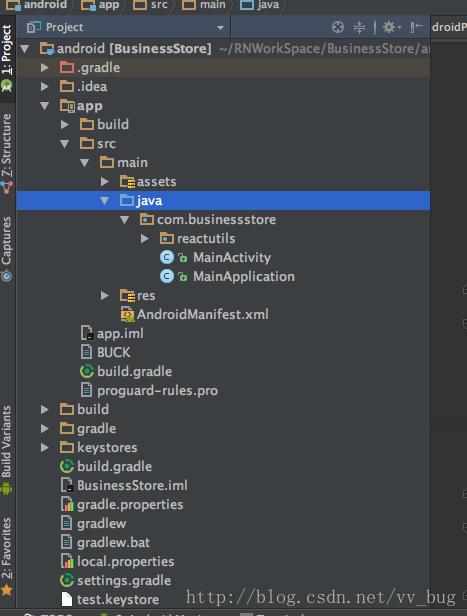
我们看到,帮我们创建了一个MainActivity跟一个MainApplication,我们先看一下MainActivity:
package com.businessstore;
import com.facebook.react.ReactActivity;
public class MainActivity extends ReactActivity {
/**
* Returns the name of the main component registered from javascript.
* This is used to schedule rendering of the component.
*/
@Override
protected String getMainComponentName() {
return "BusinessStore";
}
}
很简单,就一行代码getMainComponentName,然后返回我们的组件名字,这个名字即为我们在index.android.js中注册的组件名字:
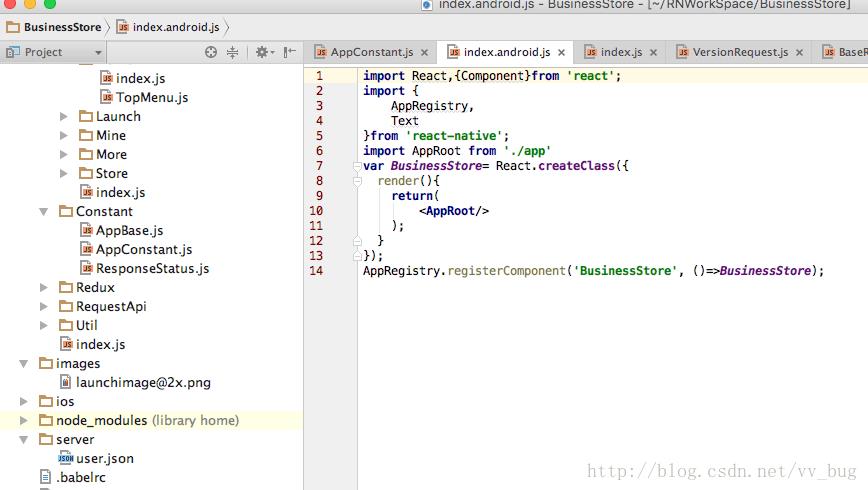
然后我们看看MainApplication长啥样:
public class MainApplication extends Application implements ReactApplication {
private final ReactNativeHost mReactNativeHost = new ReactNativeHost(this) {
@Override
protected boolean getUseDeveloperSupport() {
return BuildConfig.DEBUG;
}
@Override
protected List<ReactPackage> getPackages() {
return Arrays.<ReactPackage>asList(
new MainReactPackage()
);
}
};
@Override
public ReactNativeHost getReactNativeHost() {
return mReactNativeHost;
}
@Override
public void onCreate() {
super.onCreate();
SoLoader.init(this, /* native exopackage */ false);
}
}
也是没有几行代码…..
好啦~那我们的rn页面是怎么出来的呢? 不急,我们来一步一步往下看,首先点开MainActivity:
public class MainActivity extends ReactActivity {
/**
* Returns the name of the main component registered from JavaScript.
* This is used to schedule rendering of the component.
*/
@Override
protected String getMainComponentName() {
return "BusinessStore";
}
}一个activity要显示一个页面的话肯定得setContentView,既然我们的activity没有,然后就找到它的父类ReactActivity:
public abstract class ReactActivity extends Activity
implements DefaultHardwareBackBtnHandler, PermissionAwareActivity {
private final ReactActivityDelegate mDelegate;
protected ReactActivity() {
mDelegate = createReactActivityDelegate();
}
/**
* Returns the name of the main component registered from JavaScript.
* This is used to schedule rendering of the component.
* e.g. "MoviesApp"
*/
protected @Nullable String getMainComponentName() {
return null;
}
/**
* Called at construction time, override if you have a custom delegate implementation.
*/
protected ReactActivityDelegate createReactActivityDelegate() {
return new ReactActivityDelegate(this, getMainComponentName());
}
@Override
protected void onCreate(Bundle savedInstanceState) {
super.onCreate(savedInstanceState);
mDelegate.onCreate(savedInstanceState);
}
@Override
protected void onPause() {
super.onPause();
mDelegate.onPause();
}
@Override
protected void onResume() {
super.onResume();
mDelegate.onResume();
}
@Override
protected void onDestroy() {
super.onDestroy();
mDelegate.onDestroy();
}
@Override
public void onActivityResult(int requestCode, int resultCode, Intent data) {
mDelegate.onActivityResult(requestCode, resultCode, data);
}
@Override
public boolean onKeyUp(int keyCode, KeyEvent event) {
return mDelegate.onKeyUp(keyCode, event) || super.onKeyUp(keyCode, event);
}
@Override
public void onBackPressed() {
if (!mDelegate.onBackPressed()) {
super.onBackPressed();
}
}
@Override
public void invokeDefaultOnBackPressed() {
super.onBackPressed();
}
@Override
public void onNewIntent(Intent intent) {
if (!mDelegate.onNewIntent(intent)) {
super.onNewIntent(intent);
}
}
@Override
public void requestPermissions(
String[] permissions,
int requestCode,
PermissionListener listener) {
mDelegate.requestPermissions(permissions, requestCode, listener);
}
@Override
public void onRequestPermissionsResult(
int requestCode,
String[] permissions,
int[] grantResults) {
mDelegate.onRequestPermissionsResult(requestCode, permissions, grantResults);
}
protected final ReactNativeHost getReactNativeHost() {
return mDelegate.getReactNativeHost();
}
protected final ReactInstanceManager getReactInstanceManager() {
return mDelegate.getReactInstanceManager();
}
protected final void loadApp(String appKey) {
mDelegate.loadApp(appKey);
}
}代码也不是很多,可见,我们看到了activity的很多生命周期方法,然后都是由一个叫mDelegate的类给处理掉了,所以我们继续往下走看看mDelegate:
// Copyright 2004-present Facebook. All Rights Reserved.
package com.facebook.react;
import android.annotation.TargetApi;
import android.app.Activity;
import android.content.Context;
import android.content.Intent;
import android.net.Uri;
import android.os.Build;
import android.os.Bundle;
import android.provider.Settings;
import android.support.v4.app.FragmentActivity;
import android.view.KeyEvent;
import android.widget.Toast;
import com.facebook.common.logging.FLog;
import com.facebook.infer.annotation.Assertions;
import com.facebook.react.bridge.Callback;
import com.facebook.react.common.ReactConstants;
import com.facebook.react.devsupport.DoubleTapReloadRecognizer;
import com.facebook.react.modules.core.DefaultHardwareBackBtnHandler;
import com.facebook.react.modules.core.PermissionListener;
import javax.annotation.Nullable;
/**
* Delegate class for {@link ReactActivity} and {@link ReactFragmentActivity}. You can subclass this
* to provide custom implementations for e.g. {@link #getReactNativeHost()}, if your Application
* class doesn't implement {@link ReactApplication}.
*/
public class ReactActivityDelegate {
private final int REQUEST_OVERLAY_PERMISSION_CODE = 1111;
private static final String REDBOX_PERMISSION_GRANTED_MESSAGE =
"Overlay permissions have been granted.";
private static final String REDBOX_PERMISSION_MESSAGE =
"Overlay permissions needs to be granted in order for react native apps to run in dev mode";
private final @Nullable Activity mActivity;
private final @Nullable FragmentActivity mFragmentActivity;
private final @Nullable String mMainComponentName;
private @Nullable ReactRootView mReactRootView;
private @Nullable DoubleTapReloadRecognizer mDoubleTapReloadRecognizer;
private @Nullable PermissionListener mPermissionListener;
private @Nullable Callback mPermissionsCallback;
public ReactActivityDelegate(Activity activity, @Nullable String mainComponentName) {
mActivity = activity;
mMainComponentName = mainComponentName;
mFragmentActivity = null;
}
public ReactActivityDelegate(
FragmentActivity fragmentActivity,
@Nullable String mainComponentName) {
mFragmentActivity = fragmentActivity;
mMainComponentName = mainComponentName;
mActivity = null;
}
protected @Nullable Bundle getLaunchOptions() {
return null;
}
protected ReactRootView createRootView() {
return new ReactRootView(getContext());
}
/**
* Get the {@link ReactNativeHost} used by this app. By default, assumes
* {@link Activity#getApplication()} is an instance of {@link ReactApplication} and calls
* {@link ReactApplication#getReactNativeHost()}. Override this method if your application class
* does not implement {@code ReactApplication} or you simply have a different mechanism for
* storing a {@code ReactNativeHost}, e.g. as a static field somewhere.
*/
protected ReactNativeHost getReactNativeHost() {
return ((ReactApplication) getPlainActivity().getApplication()).getReactNativeHost();
}
public ReactInstanceManager getReactInstanceManager() {
return getReactNativeHost().getReactInstanceManager();
}
protected void onCreate(Bundle savedInstanceState) {
boolean needsOverlayPermission = false;
if (getReactNativeHost().getUseDeveloperSupport() && Build.VERSION.SDK_INT >= Build.VERSION_CODES.M) {
// Get permission to show redbox in dev builds.
if (!Settings.canDrawOverlays(getContext())) {
needsOverlayPermission = true;
Intent serviceIntent = new Intent(Settings.ACTION_MANAGE_OVERLAY_PERMISSION, Uri.parse("package:" + getContext().getPackageName()));
FLog.w(ReactConstants.TAG, REDBOX_PERMISSION_MESSAGE);
Toast.makeText(getContext(), REDBOX_PERMISSION_MESSAGE, Toast.LENGTH_LONG).show();
((Activity) getContext()).startActivityForResult(serviceIntent, REQUEST_OVERLAY_PERMISSION_CODE);
}
}
if (mMainComponentName != null && !needsOverlayPermission) {
loadApp(mMainComponentName);
}
mDoubleTapReloadRecognizer = new DoubleTapReloadRecognizer();
}
protected void loadApp(String appKey) {
if (mReactRootView != null) {
throw new IllegalStateException("Cannot loadApp while app is already running.");
}
mReactRootView = createRootView();
mReactRootView.startReactApplication(
getReactNativeHost().getReactInstanceManager(),
appKey,
getLaunchOptions());
getPlainActivity().setContentView(mReactRootView);
}
protected void onPause() {
if (getReactNativeHost().hasInstance()) {
getReactNativeHost().getReactInstanceManager().onHostPause(getPlainActivity());
}
}
protected void onResume() {
if (getReactNativeHost().hasInstance()) {
getReactNativeHost().getReactInstanceManager().onHostResume(
getPlainActivity(),
(DefaultHardwareBackBtnHandler) getPlainActivity());
}
if (mPermissionsCallback != null) {
mPermissionsCallback.invoke();
mPermissionsCallback = null;
}
}
protected void onDestroy() {
if (mReactRootView != null) {
mReactRootView.unmountReactApplication();
mReactRootView = null;
}
if (getReactNativeHost().hasInstance()) {
getReactNativeHost().getReactInstanceManager().onHostDestroy(getPlainActivity());
}
}
public void onActivityResult(int requestCode, int resultCode, Intent data) {
if (getReactNativeHost().hasInstance()) {
getReactNativeHost().getReactInstanceManager()
.onActivityResult(getPlainActivity(), requestCode, resultCode, data);
} else {
// Did we request overlay permissions?
if (requestCode == REQUEST_OVERLAY_PERMISSION_CODE && Build.VERSION.SDK_INT >= Build.VERSION_CODES.M) {
if (Settings.canDrawOverlays(getContext())) {
if (mMainComponentName != null) {
loadApp(mMainComponentName);
}
Toast.makeText(getContext(), REDBOX_PERMISSION_GRANTED_MESSAGE, Toast.LENGTH_LONG).show();
}
}
}
}
public boolean onKeyUp(int keyCode, KeyEvent event) {
if (getReactNativeHost().hasInstance() && getReactNativeHost().getUseDeveloperSupport()) {
if (keyCode == KeyEvent.KEYCODE_MENU) {
getReactNativeHost().getReactInstanceManager().showDevOptionsDialog();
return true;
}
boolean didDoubleTapR = Assertions.assertNotNull(mDoubleTapReloadRecognizer)
.didDoubleTapR(keyCode, getPlainActivity().getCurrentFocus());
if (didDoubleTapR) {
getReactNativeHost().getReactInstanceManager().getDevSupportManager().handleReloadJS();
return true;
}
}
return false;
}
public boolean onBackPressed() {
if (getReactNativeHost().hasInstance()) {
getReactNativeHost().getReactInstanceManager().onBackPressed();
return true;
}
return false;
}
public boolean onNewIntent(Intent intent) {
if (getReactNativeHost().hasInstance()) {
getReactNativeHost().getReactInstanceManager().onNewIntent(intent);
return true;
}
return false;
}
@TargetApi(Build.VERSION_CODES.M)
public void requestPermissions(
String[] permissions,
int requestCode,
PermissionListener listener) {
mPermissionListener = listener;
getPlainActivity().requestPermissions(permissions, requestCode);
}
public void onRequestPermissionsResult(
final int requestCode,
final String[] permissions,
final int[] grantResults) {
mPermissionsCallback = new Callback() {
@Override
public void invoke(Object... args) {
if (mPermissionListener != null && mPermissionListener.onRequestPermissionsResult(requestCode, permissions, grantResults)) {
mPermissionListener = null;
}
}
};
}
private Context getContext() {
if (mActivity != null) {
return mActivity;
}
return Assertions.assertNotNull(mFragmentActivity);
}
private Activity getPlainActivity() {
return ((Activity) getContext());
}
}
我们终于看到了一些有用的代码了,这个类就是处理跟activity生命周期相关的一些方法,包括(给activity添加contentview、监听用户回退、按键、6.0的一些运行时权限等等…)我们看到onCreate方法:
protected void onCreate(Bundle savedInstanceState) {
boolean needsOverlayPermission = false;
if (getReactNativeHost().getUseDeveloperSupport() && Build.VERSION.SDK_INT >= Build.VERSION_CODES.M) {
// Get permission to show redbox in dev builds.
if (!Settings.canDrawOverlays(getContext())) {
needsOverlayPermission = true;
Intent serviceIntent = new Intent(Settings.ACTION_MANAGE_OVERLAY_PERMISSION, Uri.parse("package:" + getContext().getPackageName()));
FLog.w(ReactConstants.TAG, REDBOX_PERMISSION_MESSAGE);
Toast.makeText(getContext(), REDBOX_PERMISSION_MESSAGE, Toast.LENGTH_LONG).show();
((Activity) getContext()).startActivityForResult(serviceIntent, REQUEST_OVERLAY_PERMISSION_CODE);
}
}
if (mMainComponentName != null && !needsOverlayPermission) {
loadApp(mMainComponentName);
}
mDoubleTapReloadRecognizer = new DoubleTapReloadRecognizer();
}我们看到这么一个判断,这个是做什么的呢?是为了检测是不是具有弹出悬浮窗的权限:
if (getReactNativeHost().getUseDeveloperSupport() && Build.VERSION.SDK_INT >= Build.VERSION_CODES.M) {
// Get permission to show redbox in dev builds.
if (!Settings.canDrawOverlays(getContext())) {getReactNativeHost().getUseDeveloperSupport()返回的即为我们在MainApplication中写的:
@Override
protected boolean getUseDeveloperSupport() {
return BuildConfig.DEBUG;
}
也就是说,当我们运行debug包的时候,会去检测app是不是具有弹出悬浮窗的权限,没有权限的话就会去请求权限,悬浮窗即为rn的调试menu:
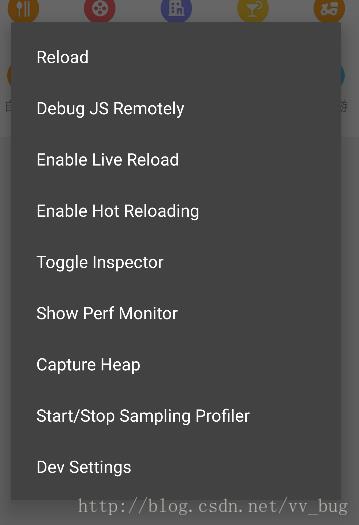
好啦~!有点偏离我们今天的主题了,我们继续往下走…往下我们看到会去执行一个叫loadApp的方法:
if (mMainComponentName != null && !needsOverlayPermission) {
loadApp(mMainComponentName);
}我们点开loadApp:
protected void loadApp(String appKey) {
if (mReactRootView != null) {
throw new IllegalStateException("Cannot loadApp while app is already running.");
}
mReactRootView = createRootView();
mReactRootView.startReactApplication(
getReactNativeHost().getReactInstanceManager(),
appKey,
getLaunchOptions());
getPlainActivity().setContentView(mReactRootView);
}好啦~~! 看到这里我们看到直接给activity设置了一个叫mReactRootView的组件,而这个组件正是rn封装的组件,我们在js中写的组件都会被转换成native组件,然后添加进mReactRootView这个组件中,那么问题来了,这些rn的组件又是在何时添加进我们的mReactRootView这个组件的呢???我们继续往下走,看到rootview有一个startReactApplication方法:
public void startReactApplication(
ReactInstanceManager reactInstanceManager,
String moduleName,
@Nullable Bundle launchOptions) {
UiThreadUtil.assertOnUiThread();
// TODO(6788889): Use POJO instead of bundle here, apparently we can't just use WritableMap
// here as it may be deallocated in native after passing via JNI bridge, but we want to reuse
// it in the case of re-creating the catalyst instance
Assertions.assertCondition(
mReactInstanceManager == null,
"This root view has already been attached to a catalyst instance manager");
mReactInstanceManager = reactInstanceManager;
mJSModuleName = moduleName;
mLaunchOptions = launchOptions;
if (!mReactInstanceManager.hasStartedCreatingInitialContext()) {
mReactInstanceManager.createReactContextInBackground();
}
// We need to wait for the initial onMeasure, if this view has not yet been measured, we set which
// will make this view startReactApplication itself to instance manager once onMeasure is called.
if (mWasMeasured) {
attachToReactInstanceManager();
}
}我们看到这么一行代码:
if (!mReactInstanceManager.hasStartedCreatingInitialContext()) {
mReactInstanceManager.createReactContextInBackground();
}看名字就知道肯定是加载了某些东西,可是点进去我们发现居然是一个抽象的方法,尴尬了~~!!:
public abstract void createReactContextInBackground();那么肯定有它的实现类,我们看到这个mReactInstanceManager是我们在调用loadApp这个方法的时候传进入的:
protected void loadApp(String appKey) {
if (mReactRootView != null) {
throw new IllegalStateException("Cannot loadApp while app is already running.");
}
mReactRootView = createRootView();
mReactRootView.startReactApplication(
getReactNativeHost().getReactInstanceManager(),
appKey,
getLaunchOptions());
getPlainActivity().setContentView(mReactRootView);
}而mReactInstanceManager又是调用getReactNativeHost().getReactInstanceManager()方法获取的,getReactNativeHost()这个返回的对象即为我们在MainApplication中创建的host对象:
public class MainApplication extends Application implements ReactApplication {
private static final String FILE_NAME = "index.android";
private final ReactNativeHost mReactNativeHost = new ReactNativeHost(this) {然后我们顺着getReactNativeHost().getReactInstanceManager()一直往下找最后发现mReactInstanceManager的实现类在这里被创建了:
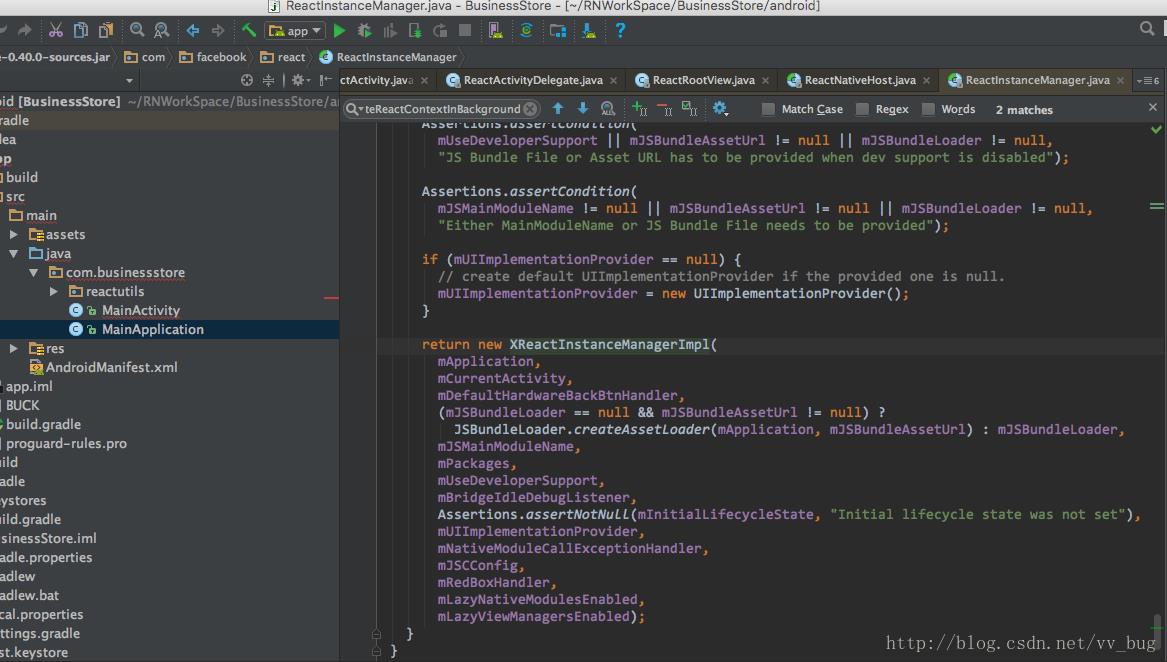
我们赶紧找到XReactInstanceManagerImpl类,然后看一下createReactContextInBackground这个方法:
@Override
public void createReactContextInBackground() {
Assertions.assertCondition(
!mHasStartedCreatingInitialContext,
"createReactContextInBackground should only be called when creating the react " +
"application for the first time. When reloading JS, e.g. from a new file, explicitly" +
"use recreateReactContextInBackground");
mHasStartedCreatingInitialContext = true;
recreateReactContextInBackgroundInner();
}然后我们继续往下:
private void recreateReactContextInBackgroundInner() {
...
@Override
public void onPackagerStatusFetched(final boolean packagerIsRunning) {
UiThreadUtil.runOnUiThread(
new Runnable() {
@Override
public void run() {
...
recreateReactContextInBackgroundFromBundleLoader();
}
}
});
}
});
}
return;
}我们找到recreateReactContextInBackgroundFromBundleLoader继续往下:
private void recreateReactContextInBackgroundFromBundleLoader() {
recreateReactContextInBackground(
new JSCJavaScriptExecutor.Factory(mJSCConfig.getConfigMap()),
mBundleLoader);
}然后看到recreateReactContextInBackground方法:
private void recreateReactContextInBackground(
JavaScriptExecutor.Factory jsExecutorFactory,
JSBundleLoader jsBundleLoader) {
UiThreadUtil.assertOnUiThread();
ReactContextInitParams initParams =
new ReactContextInitParams(jsExecutorFactory, jsBundleLoader);
if (mReactContextInitAsyncTask == null) {
// No background task to create react context is currently running, create and execute one.
mReactContextInitAsyncTask = new ReactContextInitAsyncTask();
mReactContextInitAsyncTask.executeOnExecutor(AsyncTask.THREAD_POOL_EXECUTOR, initParams);
} else {
// Background task is currently running, queue up most recent init params to recreate context
// once task completes.
mPendingReactContextInitParams = initParams;
}
}recreateReactContextInBackground这就是我们今天需要找的方法,传递了两个参数:一个是执行js代码的线程池、另外一个是我们bundle文件的加载器(bundle文件可以是我们的npm服务器中的文件(debug模式),也可以是我们assert目录中的bundle文件(发布版))。
既然如此,那我们热更新方案是不是可以这样呢?
1、请求服务器接口,当接口中返回的版本号跟我们rn中存储的版本号不一致的时候,那么这个时候就需要更新版本了。
2、服务器接口返回一个jsbundle文件的下载地址,然后我们app中拿到地址下载到本地,替换掉当前版本的jsbundle文件。
3、重新执行一下recreateReactContextInBackground方法,让app重新加载新的jsbundle文件。
好啦~! 有了思路以后,我们就可以写我们的代码了:
首先,我们模拟一个后台接口:
{
"url": "/business/version",
"method": "post",
"response": {
"code": "0",
"message": "请求成功",
"body": {
"versionName": "2.0.0",
"description":"添加了热更新功能",
"url":"http://www.baidu.com"
}
}
},然后在我们的rn中我们对应定义了一个常量叫version:
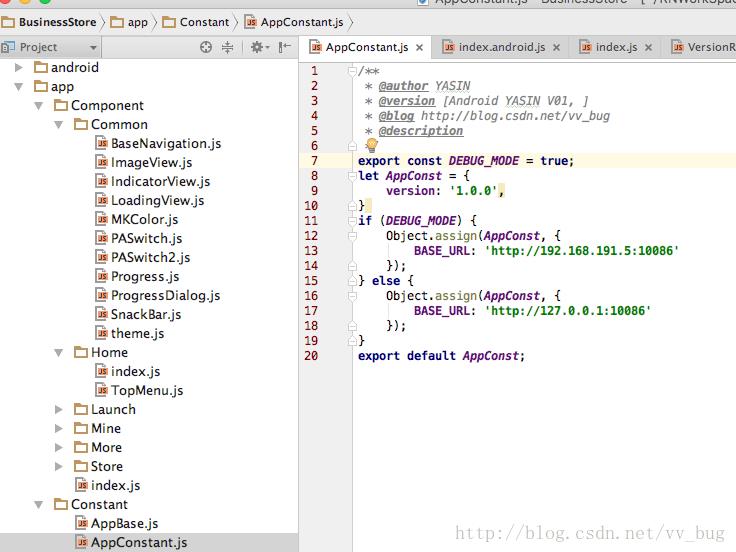
可以看到我们rn中定义的为1.0.0,所以待会我去请求接口,当接口返回的2.0.0不等于1.0.0的时候,我就去下载更新bundle文件了,于是在我们rn主页面的时候,我们就发送一个请求,然后做判断:
componentDidMount() {
this._versionCheck();
}
_versionCheck() {
this.versionRequest = new HomeMenuRequest(null, 'POST');
this.versionRequest.start((version)=> {
version = version.body;
if (version && version.versionName != AppConstant.version) {
if (Platform.OS == 'android') {
Alert.alert(
'发现新版本,是否升级?',
`版本号: ${version.versionName}\\n版本描述: ${version.description}`,
[
{
text: '是',
onPress: () => {
this.setState({
currProgress: Math.random() * 80,
modalVisible: true
});
NativeModules.UpdateAndroid.doUpdate('index.android.bundle_2.0', (progress)=> {
let pro = Number.parseFloat('' + progress);
if (pro >= 100) {
this.setState({
modalVisible: false,
currProgress: 100
});
} else {
this.setState({
currProgress: pro
});
}
});
}
},
{
text: '否'
}
]
)
}
}
}, (erroStr)=> {
});
}
}会弹出一个对话框:
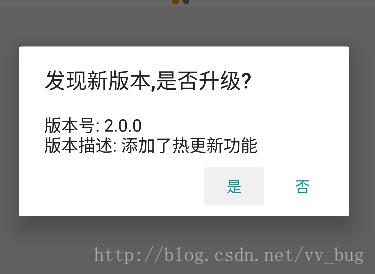
当我们点击是的时候:
NativeModules.UpdateAndroid.doUpdate('index.android.bundle_2.0', (progress)=> {
let pro = Number.parseFloat('' + progress);
if (pro >= 100) {
this.setState({
modalVisible: false,
currProgress: 100
});
} else {
this.setState({
currProgress: pro
});
}
});我们执行了native中的doUpdate并传递了两个参数,一个是下载地址,一个是当native完成热更新后的回调:
NativeModules.UpdateAndroid.doUpdate()这里声明一下,因为我这边用的服务器是mock的服务器,所以没法放一个文件到服务器上,我就直接把需要下载的bundle_2.0放在了跟1.0同级的一个目录中了,然后我们去copy 2.0到内存卡(模拟从网络上获取),替换掉1.0的版本。

再次声明,我们发布apk的时候需要把本地的js文件打成bundle,然后丢到assets目录中,所以最初的版本应该是index.android.bundle_1.0,这里出现了一个index.android.bundle_2.0是为了模拟从服务器下载,我就直接丢在了assert目录了(正常这个文件是在我们的远程服务器中的)。
如果还不知道怎么发布apk的童鞋可以去看我前面的一篇博客:
接下来就看看我们native的代码如何实现了….
我就直接拿发布版的例子来说了,我们首先看看我们的MainApplication中该怎么写:
public class MainApplication extends Application implements ReactApplication {
private static final String FILE_NAME = "index.android";
private final ReactNativeHost mReactNativeHost = new ReactNativeHost(this) {
@Override
protected boolean getUseDeveloperSupport() {
//这里返回false的话即为发布版,否则为测试版
//发布版的话,app默认就会去assert目录中找bundle文件,
// 如果为测试版的话,就回去npm服务器上获取bundle文件
return false;
}
@Override
protected List<ReactPackage> getPackages() {
return Arrays.<ReactPackage>asList(
new MainReactPackage(),
new VersionAndroidPackage(),
new UpdateAndroidPackage()
);
}
@Nullable
@Override
protected String getJSBundleFile() {
File file = new File(getExternalCacheDir(), FILE_NAME);
if (file != null && file.length() > 0) {
return file.getAbsolutePath();
}
return super.getJSBundleFile();
}
};
@Override
public ReactNativeHost getReactNativeHost() {
return mReactNativeHost;
}
@Override
public void onCreate() {
super.onCreate();
copyBundle();
SoLoader.init(this, /* native exopackage */ false);
}
private void copyBundle(){
if (!Environment.getExternalStorageState().equals(Environment.MEDIA_MOUNTED)) {
return;
}
File file = new File(getExternalCacheDir(), FILE_NAME);
if (file != null && file.length() > 0) {
return;
}
BufferedInputStream bis = null;
BufferedOutputStream bos = null;
try {
bis = new BufferedInputStream(getAssets().open("index.android.bundle_1.0"));
bos = new BufferedOutputStream(new FileOutputStream(file));
int len = -1;
byte[] buffer = new byte[512];
while ((len = bis.read(buffer)) != -1) {
bos.write(buffer, 0, len);
bos.flush();
}
} catch (Exception e) {
e.printStackTrace();
} finally {
try {
if (bis != null) {
bis.close();
}
if (bos != null) {
bos.close();
}
} catch (IOException e) {
e.printStackTrace();
}
}
}
}
可以看到我们多重写了一个方法,然后还写了一段copy bundle文件到内存卡的代码:
@Nullable
@Override
protected String getJSBundleFile() {
File file = new File(getExternalCacheDir(), FILE_NAME);
if (file != null && file.length() > 0) {
return file.getAbsolutePath();
}
return super.getJSBundleFile();
}
};因为rn默认是去assert目录中加载bundle文件的,当指定了bundle文件的地址后,rn会去加载我们指定的目录。所以当我们第一次运行app的时候,我们首先把assert中的bundle文件拷贝到了内存卡,然后让rn去内存卡中加在bundle文件。
好啦~~!!此时的rn已经知道去内存卡中加载bundle文件了,我们要做的就是:
1、根据rn 中传递的地址去下载最新的bundle文件。
2、替换掉内存卡中的bundle文件。
3、调用createReactContextInBackground方法重新加载bundle文件。
至于rn怎么去跟native交互,我这里简单的说一下哈:
首先我们需要建一个叫UpdateAndroid去继承ReactContextBaseJavaModule,然后注释声明为react的module:
@ReactModule(name = "UpdateAndroid")
public class UpdateAndroid extends ReactContextBaseJavaModule {然后重写里面的一个叫getName的方法给这个module取一个名字:
@Override
public String getName() {
return "UpdateAndroid";
}最后声明一个类方法,让rn调取:
@ReactMethod
public void doUpdate(String url, Callback callback) {
if (task == null) {
task = new UpdateTask(callback);
task.execute("index.android.bundle_2.0");
}
}全部代码:
@ReactModule(name = "UpdateAndroid")
public class UpdateAndroid extends ReactContextBaseJavaModule {
private UpdateTask task;
public UpdateAndroid(ReactApplicationContext reactContext) {
super(reactContext);
}
@ReactMethod
public void doUpdate(String url, Callback callback) {
if (task == null) {
task = new UpdateTask(callback);
task.execute("index.android.bundle_2.0");
}
}
@Override
public String getName() {
return "UpdateAndroid";
}
private class UpdateTask extends AsyncTask<String, Float, File> {
private Callback callback;
private static final String FILE_NAME = "index.android";
private UpdateTask(Callback callback) {
this.callback = callback;
}
@Override
protected File doInBackground(String... params) {
return downloadBundle(params[0]);
}
@Override
protected void onProgressUpdate(Float... values) {
// if (callback != null && values != null && values.length > 0){
// callback.invoke(values[0]);
// Log.e("TAG", "progress-->" + values[0]);
// }
}
@Override
protected void onPostExecute(File file) {
if (callback != null) callback.invoke(100f);
//重写初始化rn组件
onJSBundleLoadedFromServer(file);
}
private void onJSBundleLoadedFromServer(File file) {
if (file == null || !file.exists()) {
Log.i(TAG, "download error, check URL or network state");
return;
}
Log.i(TAG, "download success, reload js bundle");
Toast.makeText(getCurrentActivity(), "Downloading complete", Toast.LENGTH_SHORT).show();
try {
ReactApplication application = (ReactApplication) getCurrentActivity().getApplication();
Class<?> RIManagerClazz = application.getReactNativeHost().getReactInstanceManager().getClass();
Method method = RIManagerClazz.getDeclaredMethod("recreateReactContextInBackground",
JavaScriptExecutor.Factory.class, JSBundleLoader.class);
method.setAccessible(true);
method.invoke(application.getReactNativeHost().getReactInstanceManager(),
new JSCJavaScriptExecutor.Factory(JSCConfig.EMPTY.getConfigMap()),
JSBundleLoader.createFileLoader(file.getAbsolutePath()));
} catch (NoSuchMethodException e) {
e.printStackTrace();
} catch (IllegalAccessException e) {
e.printStackTrace();
} catch (InvocationTargetException e) {
e.printStackTrace();
} catch (IllegalArgumentException e) {
e.printStackTrace();
}
}
/**
* 模拟bundle下载链接url
*
* @param url
*/
private File downloadBundle(String url) {
if (!Environment.getExternalStorageState().equals(Environment.MEDIA_MOUNTED)) {
return null;
}
//删除以前的文件
File file = new File(getReactApplicationContext().getExternalCacheDir(), FILE_NAME);
if (file != null && file.length() > 0) {
f以上是关于React-Native 热更新尝试(Android)的主要内容,如果未能解决你的问题,请参考以下文章
Hot Reload 在 react-native android 中不起作用